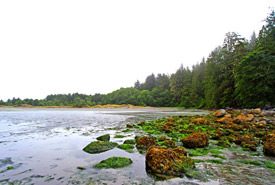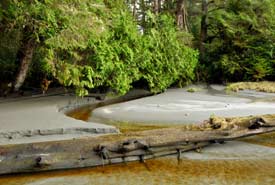Clayoquot Sound

An intertidal zone on Clayoquot Island (Photo by NCC)
Rugged coastlines, white-sand beaches and old-growth forests are defining features of Clayoquot Sound, located on Vancouver Island's west coast. The natural abundance of this area has long attracted both development and conservation interests.
The Nature Conservancy of Canada (NCC) is focused on protecting parcels of old-growth forest, freshwater systems and oceanfront habitat for salmon, coastal wolves, rare plants and other at-risk species.
The Clayoquot Sound natural area is located within the traditional territories of the Tla-o-qui-aht and Ahousaht First Nations.
Urgency
Clayoquot Sound's unique biodiversity makes it a priority for conservation efforts. Located within the Coastal Western Hemlock biogeoclimatic zone, this region encompasses a high diversity of wildlife. Residential development poses a threat to natural habitat, and NCC is working strategically to conserve ecologically significant private lands throughout the area.
History
This natural area is located within the Clayoquot Sound UNESCO Biosphere Reserve, and has long been a hub for marine research, due to the wealth of intertidal areas found here.
Featured projects

Vargas Island Conservation Area, BC (Photo by NCC)
Vargas Island Conservation Area
This waterfront conservation area was NCC's first project in Clayoquot Sound. This pristine conservation site is home to a genetically distinct sub-species of gray wolf that has adapted to hunt in the ocean, and gray whales are known to migrate through the offshore waters.
Clayoquot Island Preserve
The Nature Conservancy of Canada acquired 70 percent of Clayoquot Island in 2015 through a generous donation from the island's owner. The preserve is important for bird species, coastal sand dunes and eel-grass beds. Learn more>





